An organizational chart (or org chart) is a visual aid used to clarify who reports to whom and who is accountable for what in your organization. It generally shows the company owner or section head on top with subordinates below, from the arrangement of a drawing, diagram, flow graph, or picture.
Thanks for Pingboard for ridding this report. Pingboard provides an easy to use organizational chart tool which you can get at no cost, assisting you to create and keep your personal org chart. You could even sign up for a free trial of the innovative organizational charting features.
Visit Pingboard
1. Select the Type of Organizational Chart You Need
For the purpose of handling your small business, there are 3 types of organizational charts you’ll probably want to create — hierarchical/top-down, functional by section, and matrixed or cross-functional.
Hierarchical/Top-Down Organizational Chart
A hierarchical organizational graph is a diagram which shows an organization’s reporting structure in the top-down, starting with the business owner or department supervisor on top of the chart and employees that report to them appearing under their name. All roles appear in boxes attached by a line to illustrate reporting associations.
Sample Hierarchical/Top-Down Organizational Chart
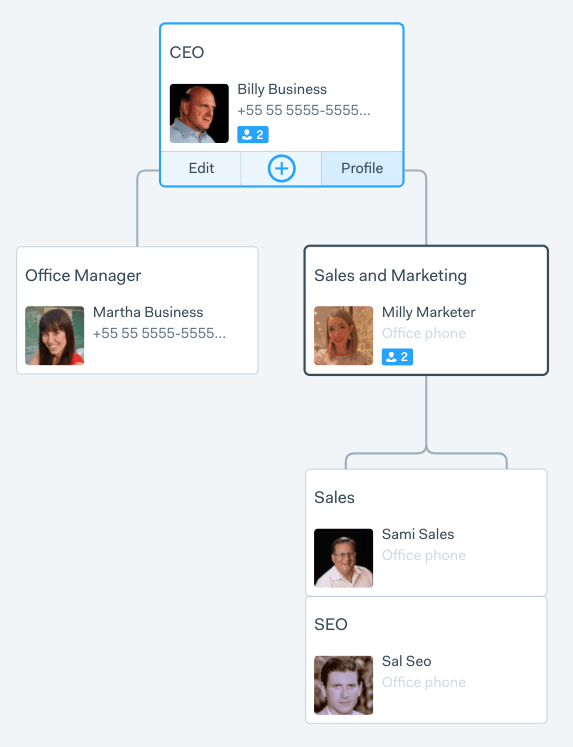
Sample hierarchical org graph built using Pingboard
Most small companies will utilize a top-level organizational chart because it’s the easier of the three different types. If your business is made up of you and a couple of staff members that report to you, your organizational chart would show your name at the top and your workers’ names under.
It’s somewhat more complex when you begin to add supervisory staff and division heads, or have open, unfilled positions, but the basic idea is the same. The sample organizational chart shown above was drawn in around three minutes using the trial version of Pingboard.
Functional Organizational Chart (by Department)
Once your organization gets bigger and you start organizing your staff into departments, such as sales, finance, operations, and customer support, you will probably use a practical organizational chart. This illustrates who is accountable for each department, in addition to exactly how many, and which employees report to every manager. Here’s a good example below:
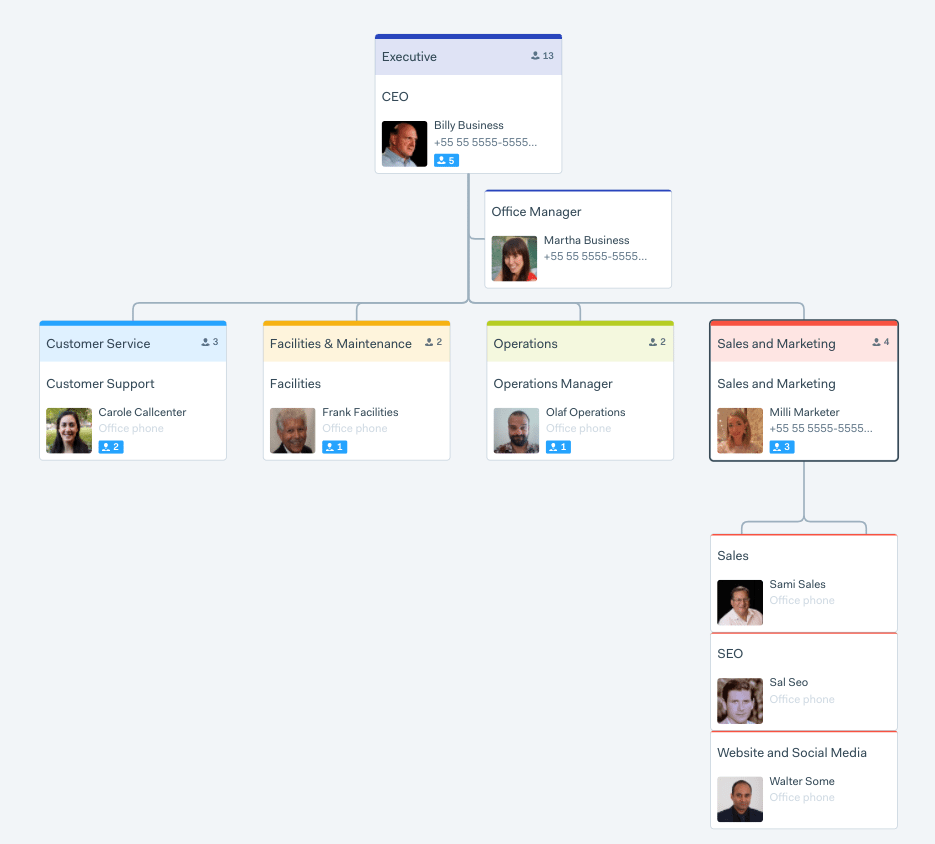
Functional org chart constructed in Pingboard with workers in each department
When you construct your organizational chart in an organizational charting app, the images are not static. By way of instance, from the picture above, you can drill down on the number of direct reports, as shown in Sales and Marketing, to see the actual names of each employee working in that section. That is a feature you won’t have if you produce an organizational chart on paper.
Following is a video showing how a user can drill down on an org chart made in Pingboard.
Matrixed/Cross-Functional Organizational Chart
A matrixed, or cross-functional, organizational chart shows multiple reporting relationships. It’s used to portray complex business organizational arrangements with job reporting relationships along with supervisory (top notch , hierarchical) connections. It reveals both supervisory relationships, such as”who’s my boss,” as well as job or team relationships.
For instance, in a little marketing firm that manages client jobs, workers report to their manager and provide deliverables to project supervisors. This sort of company would benefit by employing a matrixed, or functional, organizational chart.
2. Opt for a Free or Paid Organizational Chart Tool
It is possible to discover free tools and templates on the internet or even find accessible features within your existing office computer software systems, such as MS Office or your HR or payroll software. Or, you can discover dedicated organizational chart software to make your own. Let us review some of the more prevalent ones, starting with those who are liberated.
Free Organizational Chart Software Tools
- Pingboard has a free org charting instrument, as shown in the pictures above.
- Many paid sites offer you a free (limited functionality version) that you can use by providing an email address. Pingboard supplies a seven-day free trial on its paid organizational chart options.
- MS Office — You can create an organizational chart in many MS Office products in case you’re using the MS Office Suite in your small business.
- In MS Word, as soon as you have a file open, select Insert>Smart Art>Organizational Chart. Instructions are available here.
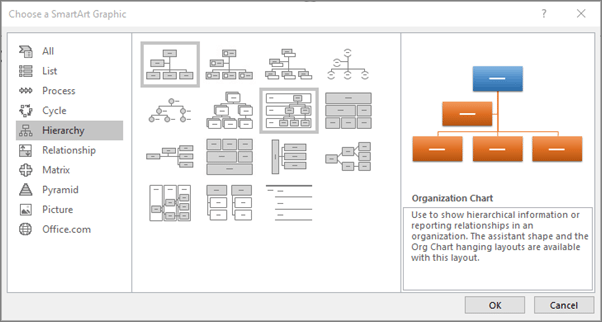
MS Office SmartArt Menu Options to Produce an Org Chart
- In MS PowerPoint, you can add text lines and boxes to draw your own organizational chart or search for free organizational chart online templates.
- In Excel, PowerPoint, and Word, it is also possible to download a free organizational graph add-in.
- Use a very simple drawing or demonstration program already on your pc, such as Google Slides.
- HR/payroll system — If you currently use an HR or payroll system like Justworks, SAP/Success Factors, or Zenefits, some can offer an organizational chart using worker data in your system.
- In the event that you simply need something quite fundamental, draw your organizational chart on paper or onto a flip chart posted in your workplace.
- Free internet templates — Try to find”free org chart template” and you will find plenty of free downloadable templates.
Paid Organizational Chart Tools
You may expect to pay between $5 to $100+ per month to get applications that lets you create organizational charts. These programs are great when you have a rapidly growing business, are creating lots of organizational charts, or need to create different diagrams in addition to organizational charts (such as flowcharts and process maps). Many of those paid organizational charting sites offer free trials, but you might need to discuss your email address for access.
Organizational chart software pricing is usually structured in various feature tiers. By way of example, Pingboard’s starter program gives three workers access to the applications, such as mobile app access, and email service in addition to the attributes in the free program. Upgrading to Pingboard’s Standard or Professional plans offers innovative features such as integrations with your HR or IT applications and accessibility for your whole staff.
The very best org charts supply tools such as the ability to drill down to see comprehensive employee information (profiles), colour code the charts, hunt the charts by title or job name and even add worker photographs.
A number of Pingboard’s more practical features are displayed below. The first ten attributes Can Be Found in Pingboard’s free version, while the four attributes shown at the base require an update:
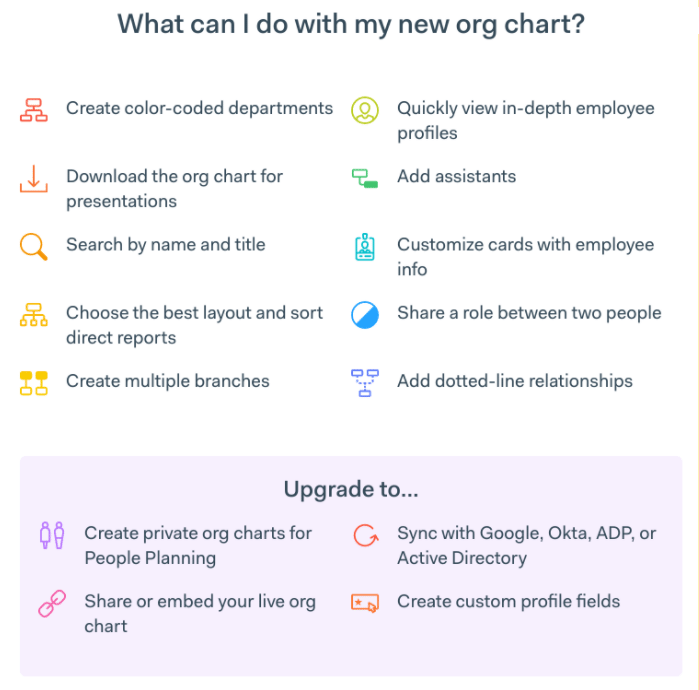
Instance of free and paid org chart tools accessible on Pingboard
3. Fill Out Your Organizational Chart
Based on the reason you are generating your organizational chart, every placeholder can comprise as little as a name and title or as much info as you can fit into every box. Our recommendation for many organizational charts would be to include the following in each box:
- Title (leave name blank if position is open)
- Department (for example, sales/marketing, accounting, operations)
- Role or Job title (by Way of Example, sales rep, manager, clerk, acct mgr)
- Optional:
- Location (use if workers are diverse, i.e., NY, TX, CA, or if You’ve Got multiple buildings)
- Contact Information
- Telephone (work phone extension or mobile phone)
- Mail (work or home email to be used for company contact)
- Photo / thoughts taken
A few org chart software lets you add extra information so it works more like an employee directory. Here is a good illustration from Pingboard showing confidential information that just the Pingboard admin and the employee can view, for example, employee’s shirt size and dietary restrictions.
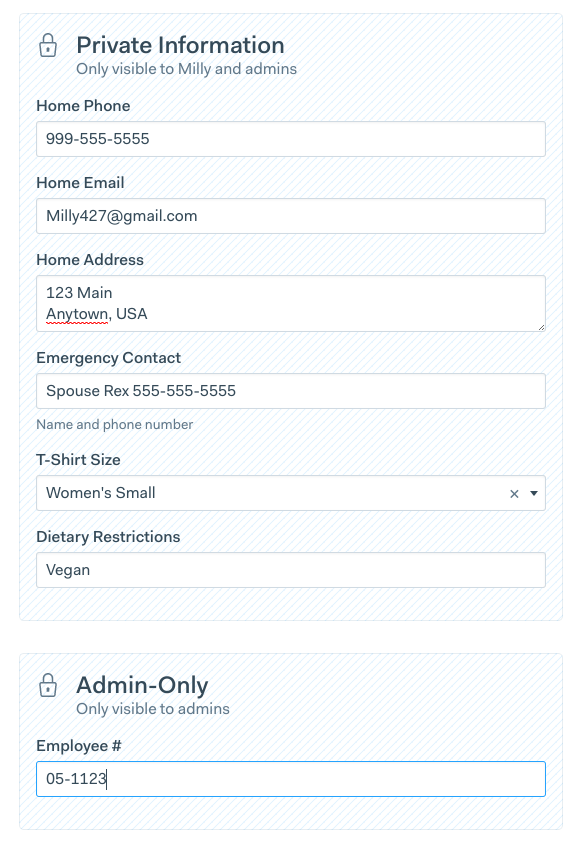
Confidential employee information available on Pingboard, visible only to admins and the employee
Why Your Small Company Needs an Organizational Chart
You don’t need to have an organizational chart, but as an HR best practice, we recommend you do. There are several reasons why:
- To enhance communication across divisions and teams
- To save time by clarifying who does what
- To attest to business partners (banks, finance partners) your business is structured for achievement and that you’ve got individuals filling vital roles
- That Will Help You plan for growth and transition
An organizational chart is a tool, like a telephone list, to increase communication by clarifying your coverage arrangement. It saves time that employees, particularly new ones, do not need to ask,”Who’s our IT person?” ,”Who will I ask a question regarding my worker benefits?” Or”Who does my own boss report to?”
Organizational charts are also often important if you are applying for financing, as banks, investors, lenders, or the SBA may want to observe how your organization is structured to make sure it’s very likely to be successful and your company can pay back a loan.
In fact, we urge an HR best practice of having two versions of your organizational chart — one showing current employee reporting associations (to discuss with your employees ) and one which shows how your company is going to be organised if you grow/expand, or whenever a team member leaves.
The next version of your org chart will probably have unfilled positions in it — placeholders for rankings you aspire to hire later on. Here’s an illustration showing two unfilled places:
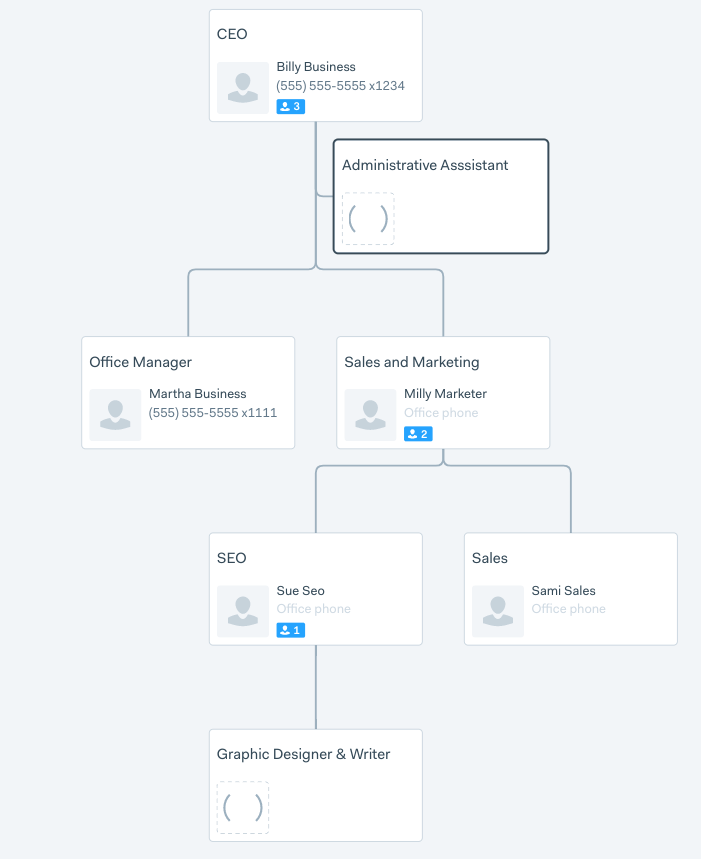
Sample org chart with unfilled positions made using the free version of Pingboard
Benefits of Using an Online Organizational Chart
One of the benefits of using a cloud-based organizational graph such as Pingboard is that you can often sync it to existing programs, so that if information changes in one system, like google’s G-Suite, Okta, Azure Active Directory, or ADP, it’ll automatically update your organizational graph, saving you time and reducing duplicate data entry and errors.
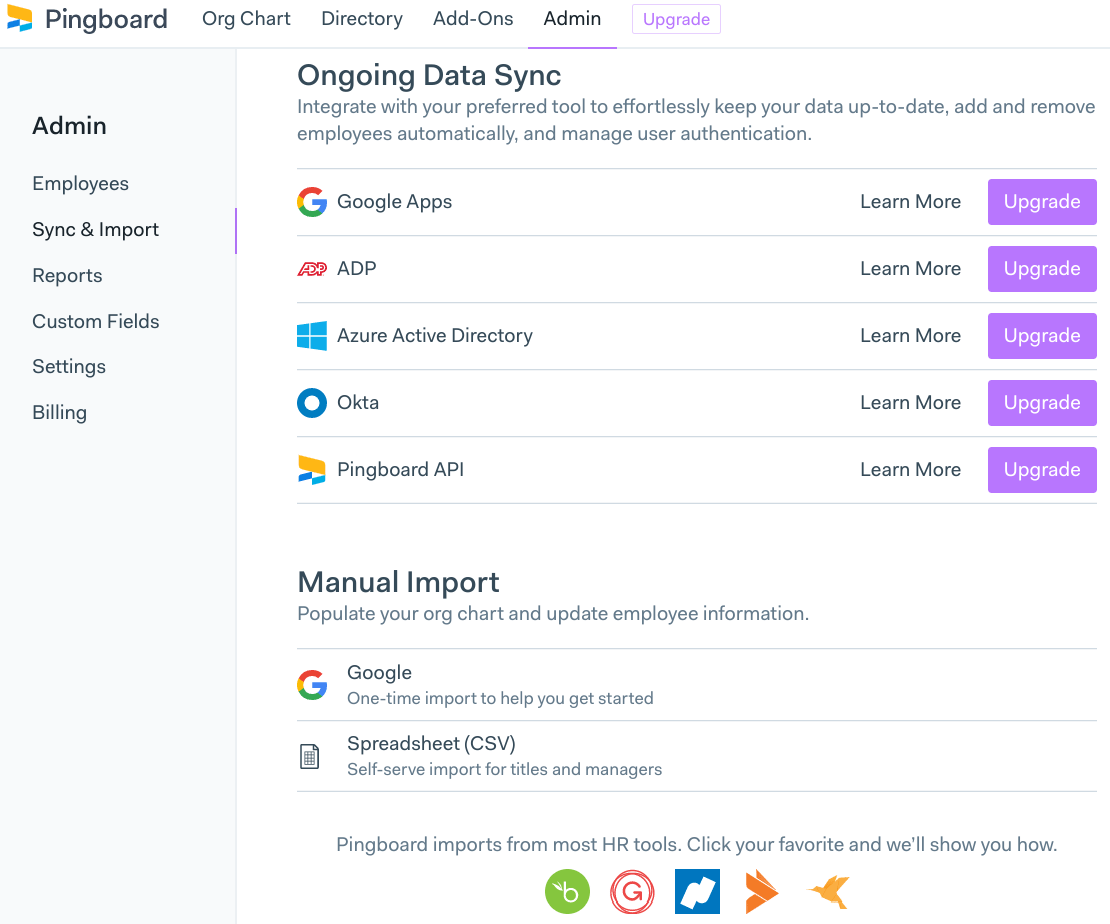
Examples of data sync and importing tools accessible on Pingboard
Another benefit that many online organizational charts offer is the ability to import your information from a spreadsheet or by the HR applications, although this generally requires an update to a paid version. Pingboard, by way of instance, lets you export information from your spreadsheet or Google, as well as HR, benefits and payroll software such as ADP, Gusto, Justworks, Zenefits, and others.
The Most Important Thing
Prior to spending precious office time creating an organizational chart, ask yourself do you really need one? In case you have two workers and they report to youpersonally, you probably don’t. But once you start to hire more staff, an organizational chart is an important tool.
We suggest that you keep your organizational chart simple in the beginning. By way of example, you can create a free organizational chart on one page using Pingboard and then update it by adding or deleting boxes, lines, or text.
Whatever you choose to do, do not forget to keep your organizational chart current as your business grows — jobs, people, and duties change. Your organizational chart will likely increase in complexity as you move from three workers to 15 to 50. So save that very first you you scribbled on the back of a napkin — you may look back on it with nostalgia a single day.
See Pingboard

